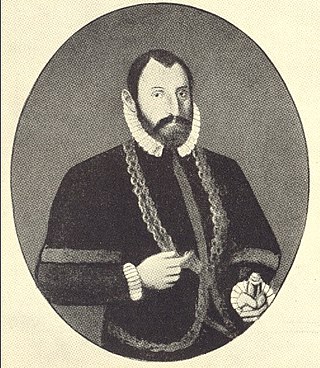
Ludwig Adolf Friedrich, 2nd Prince zu Sayn-Wittgenstein-Berleburg-Ludwigsburg, from 1861 Prince zu Sayn-Wittgenstein-Sayn, was a Russian and German aristocrat. Among his properties were the famed Mir Castle Complex and Verkiai Palace.

Louis Adolf Peter, 1st Prince of Sayn-Wittgenstein-Ludwigsburg-Berleburg, better known as Peter Wittgenstein in English, was a prince of the German dynasty of Sayn-Wittgenstein and field marshal in the Imperial Russian Army during the Napoleonic Wars. He was nicknamed the Saviour of Saint-Petersburg.

Sayn-Wittgenstein was a county of medieval Germany, located in the Sauerland of eastern North Rhine-Westphalia.

Sayn-Wittgenstein-Berleburg-Ludwigsburg, better known as Sayn-Wittgenstein-Ludwigsburg, was a cadet branch of the House of Sayn-Wittgenstein-Berleburg.

Sayn-Wittgenstein-Sayn was a county of Rhineland-Palatinate, Germany, comprising the lands of the region of Sayn. It was created as a partition of Sayn-Wittgenstein in 1607, although it was not until the next year that it obtained fully the Countship of Sayn. The succession was never clear, leading to the annexation of the county in 1623 by the Archbishop of Cologne. It was not until a treaty in 1648 that it was decided the county would pass to the sisters Ernestine and Johanette of Sayn-Wittgenstein-Sayn, under the regency of their mother, Countess Louise Juliane von Erbach (1603–1670). They partitioned the county into Sayn-Wittgenstein-Sayn-Altenkirchen and Sayn-Wittgenstein-Hachenburg soon after.
Ludwig Wittgenstein was an Austrian-British philosopher.

Christian Louis Casimir, 2nd Count of Sayn-Wittgenstein-Berleburg-Ludwigsburg was a reigning Count of Sayn-Wittgenstein-Berleburg-Ludwigsburg line of Sayn-Wittgenstein family from 1750 to 1796.
Mannus Riedesel (1662–1726) was a master builder in the early 18th century in the Counties of Wittgenstein and surrounding areas, now part of the district of Siegen-Wittgenstein in the state of North Rhine-Westphalia in the Federal Republic of Germany. At least ten structures that he built are known to exist, and are regarded as jewels of "half-timbered" Fachwerk construction." Though not well known outside Wittgenstein, his name and surviving structures are familiar to many there.
Count Jefferson von Pfeil und Klein-Ellguth is a German nobleman and a banker.

Löwenstein-Wertheim was a county of the Holy Roman Empire, part of the Franconian Circle. It was formed from the counties of Löwenstein and Wertheim and from 1488 until 1806 ruled by the House of Löwenstein-Wertheim who are morganatic descendants of the Palatinate branch of the House of Wittelsbach.
Graf August David of Sayn-Wittgenstein-Hohenstein was a Prussian politician. He was a member of the Cabinet of Three Counts, with Johann Kasimir Kolbe von Wartenberg and Alexander Hermann, Count of Wartensleben, also known due to their heavy taxation as "the great W(oes)" of Prussia. As a favorite of Johann Kasimir Kolbe von Wartenberg, he was later imprisoned at Spandau Citadel, fined 70,000 thalers and banished subsequently by Frederick William due to corruption, wastage and inefficiency.
Bernhart Otto Peter, 6th Prince of Sayn-Wittgenstein-Hohenstein is a German businessman and the current head of the Princely House of Sayn-Wittgenstein-Hohenstein.

Richard, 4th Prince of Sayn-Wittgenstein-Berleburg was Prince of Sayn-Wittgenstein-Berleburg from 1904 to 1918.

Sayn-Wittgenstein-Berleburg was one of several imperial counties and later principalities ruled by the House of Sayn-Wittgenstein.
Prinz Ludwig Ferdinand Paul Franz Stanislaus Ulrich Otto Ludolf zu Sayn-Wittgenstein-Berleburg was a highly decorated Oberst in the Wehrmacht during World War II. He was also a recipient of the Knight's Cross of the Iron Cross. The Knight's Cross of the Iron Cross was awarded to recognise extreme battlefield bravery or successful military leadership. Ludwig-Ferdinand Prinz von Sayn-Wittgenstein-Berleburg was killed on 22 November 1943 near Zhytomyr, Ukraine. He was posthumously awarded the Knight's Cross on 20 January 1944 and was also promoted to Oberst.

Prince Frederick William II of Nassau-Siegen, German: Friedrich Wilhelm II. Fürst von Nassau-Siegen, official titles: Fürst zu Nassau, Graf zu Katzenelnbogen, Vianden, Diez, Limburg und Bronkhorst, Herr zu Beilstein, Stirum, Wisch, Borculo, Lichtenvoorde und Wildenborch, Erbbannerherr des Herzogtums Geldern und der Grafschaft Zutphen, was since 1722 Fürst of Nassau-Siegen, a part of the County of Nassau. He descended from the House of Nassau-Siegen, a cadet branch of the Ottonian Line of the House of Nassau. He was the last male representative of his lineage, with him the Protestant line of the House of Nassau-Siegen became extinct.

Louis I, Count of Sayn-Wittgenstein, nicknamed "the Elder", formally "Louis I of Sayn, Count at Wittgenstein" ruled the County of Wittgenstein, on the upper reaches of the rivers Lahn and Eder, from 1558 until his death. He converted his county to Calvinism and was an influential politician in the service to the Electoral Palatinate.

Johanetta of Sayn-Wittgenstein was a German countess of the house of Sayn-Wittgenstein, who became the third wife of Count John VI, Count of Nassau-Dillenburg.

Prince August Fredrik zu Sayn-Wittgenstein-Berleburg, known professionally as August Wittgenstein, is a German-Swedish actor and member of the princely House of Sayn-Wittgenstein-Berleburg. Wittgenstein has appeared in English, German, and Swedish language films, starring in the 2013 German television movie Open Desert. He is known for his portrayals of Georg Donatus, Hereditary Grand Duke of Hesse in The Crown and Count Alfred Eckbrecht von Dürckheim-Montmartin in Ludwig II as well as his roles as Karl Tennstedt in Das Boot and Andreas Wolf in Deadwind.

Countess Sophie Polyxena Concordia of Sayn-Wittgenstein-Hohenstein, German: Sophia Polyxena Concordia Gräfin zu Sayn-Wittgenstein-Hohenstein, official titles: Gräfin zu Sayn, Wittgenstein und Hohenstein, Frau zu Homburg, Vallendar, Neumagen, Lohra und Klettenberg, was a countess from the House of Sayn-Wittgenstein-Hohenstein and through marriage Fürstin of Nassau-Siegen.

















